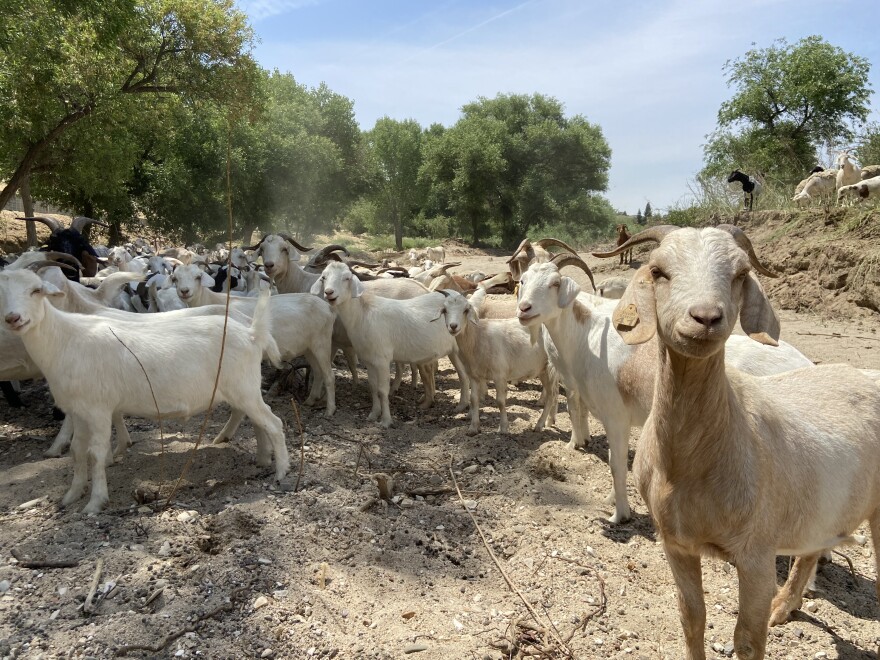Goats and sheep are grazing on the Salinas River in Paso Robles right now. It’s a tactic local governments are using to reduce wildfire risk.
On a sunny morning in Paso Robles, a herd of goats and sheep graze along the lush banks of the Salinas River. There’s an earthy smell of chewed grass in the air.
Beth Reynolds is a founder of Goat Girls LLC, the goat-grazing company working with the City of Paso Robles. She leads me to the grazing site by the river.
The animals’ heads perk up as we approach; some cautiously back away while others come right up to us, recognizing Reynolds as a familiar face.
“I just got bit by a goat,” Reynolds laughed.
Reynolds is also a professor of sheep and goat management for Cal Poly’s animal science program.
“They eat different plants in the riverbed,” Reynolds said. “There's lots of trees, willows and some brush, grasses and forbs."
Reynolds said this is the third year they’ve sent out the animals to help prevent wildfires around the Salinas River. Their task is to eat plants and vegetation that could catch fire — but it’s not just about eating.
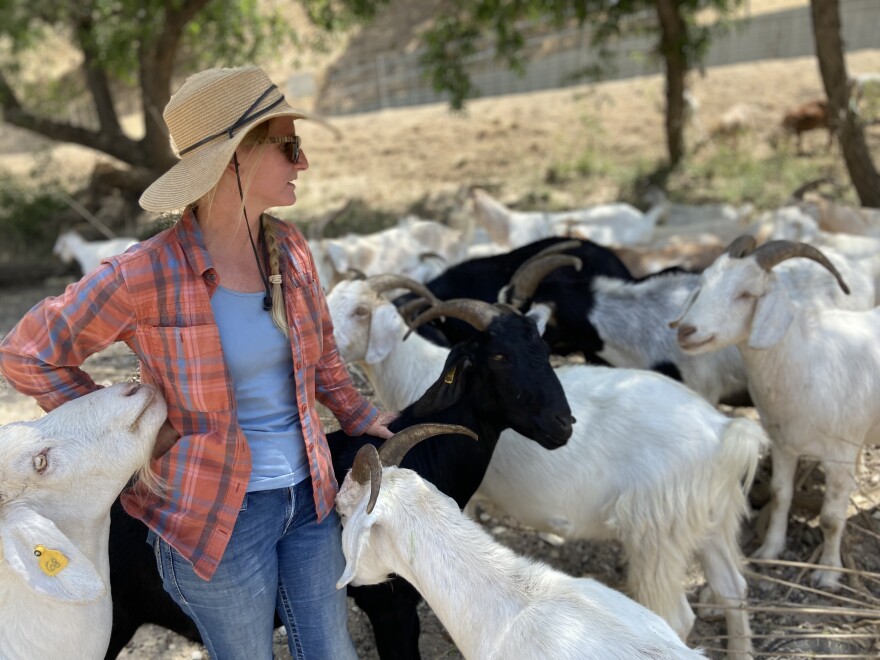
“They are pooping it out, but it's not as flammable as it was as a grass,” Reynolds said. “So they're kind of changing the way a fire would respond in the area.”
So, why goats?
Reynolds said they’re perfect for fire prevention in vegetation-rich areas, like the Salinas River, because they can stand on their hind legs to reach higher areas like trees.
“They do a good job of removing ladder fuel, which is fuel that would take a fire from the ground, take it up into the canopy and create a much more intense fire.” Reynolds said.
Fires on the Salinas River banks have been a major concern for the City of Paso Robles. In 2019, the city declared a public emergency because of multiple back-to-back wildfires.
Reynolds said fires at the Salinas River are still bound to happen– but the goal here is to make them smaller and easier to manage.
“If there is a fire, it is going to move very slowly and is easy for firefighters to access,” Reynolds said.
Jay Enns is the Battalion Chief for the Paso Robles Fire Department. He said this strategy has been effective, as fires in this area have been a lot smaller since the City started its grazing program in 2020.
“We've seen a significant drop in the size of fires,” Enns said.
Enns said one of the main advantages of grazing compared to other fire-prevention practices is the animals’ non-stop chomping. Mechanized tools like chainsaws generate noise and can only operate for hours at a time, while goats and sheep are able to constantly devour vegetation.
“They’re constantly working 24 hours a day,” Enns said.
The animals cover up to three acres a day; the goal of the Salinas River Project is for them to graze 100 acres in total.
But Enns also emphasizes the importance of combining goat grazing with mechanized equipment for the best results. He said the City always uses machinery to prepare the area for animals to graze.
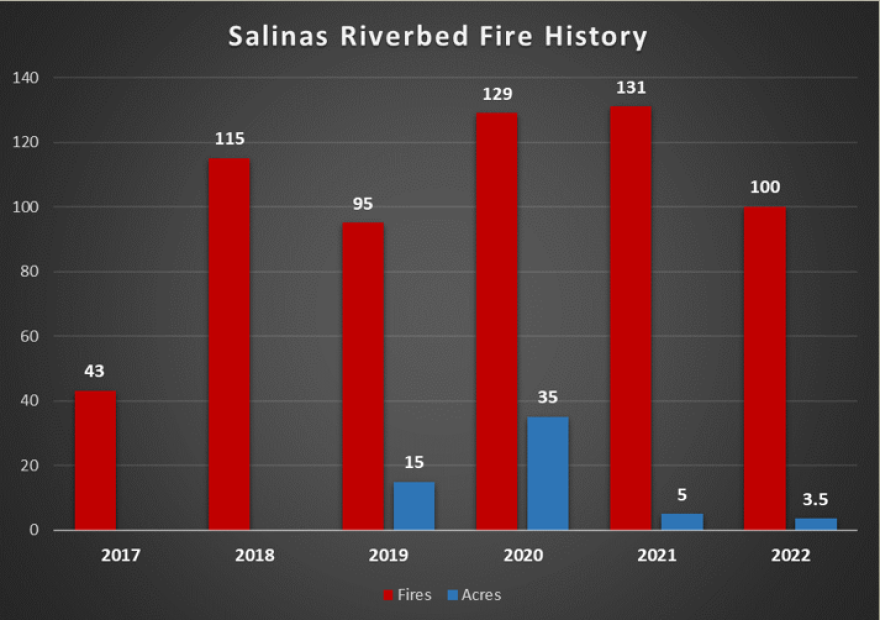
Enns hopes this program’s success will encourage other communities in San Luis Obispo County, and the rest of California, to consider grazing as a viable tool for fire prevention.
“Salinas River and Paso Robles isn't the only place where we're having these types of issues,” Enns said. “It's throughout the state of California.
Paso Robles isn’t the only place doing this– Santa Barbara County is having sheep and goats graze five different city parks through the end of the month.
Enns said he would like to see goat grazing become a more common wildfire prevention tool in California.
“I think it's underutilized,” Enns said. “I think it's just because people aren't aware of how effective it can be, and so it's easier just to fall back to what they know, which is mechanized equipment.”
Reynolds said she moves the goats into different sections of the river bank in the morning or evening depending on the vegetation’s density. At this particular site, it looks like they won’t be here for long — they’re eating quickly.
Reynolds said the benefits of goat grazing go beyond reducing the size of wildfires; grazing can remove invasive weeds and can help revive the surrounding environment.
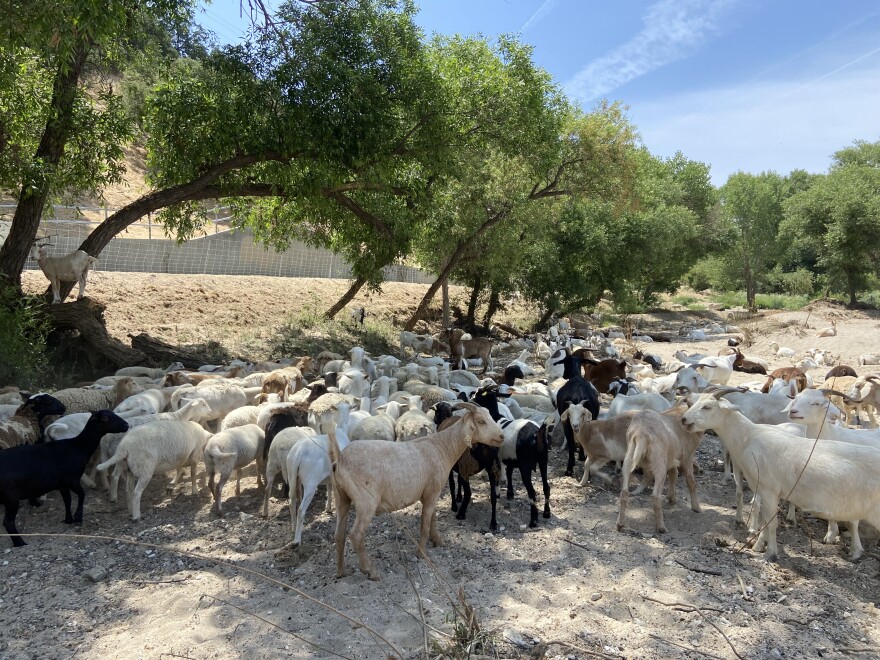
“They rock their horns on bushes and break branches, and it stimulates new growth,” Reynolds said.
Reynolds emphasized the goats’ role in restoring the environment is especially important after heavy storms and flooding wreaked havoc on the Salinas River this year.
“These banks are really interesting this year because of the flooding — there was a lot of erosion, and all the banks are just sheer cliffs,” Reynolds said.
“So the goats [are] basically sliding down it, rubbing on it and making that slope less extreme, and that is gonna be more helpful in getting it reestablished with vegetation,” Reynolds added.
Reynolds said many of the Goat Girls’ past grazing projects were around houses– But the Salinas River is a riparian corridor, a riverside ecosystem teeming with biodiversity.
Hundreds of birds, mammals, insects, reptiles and amphibians depend on this habitat.
To ensure the grazing doesn’t disrupt species in the area, Reynolds said the City of Paso Robles and the Goat Girls have been working with the California Department of Fish and Wildlife and other regulatory agencies.
“For example, there are birds nesting now here in June,” Reynolds said. “So when we're traveling down the riverbed, there are biologists that go ahead of us and basically look for bird nests.”
Reynolds said the project has also had to navigate around the unhoused population living along the Salinas River.
The goats will continue grazing here until the end of the month. Reynolds is grateful for the overwhelming support she’s received from the Paso Robles community.
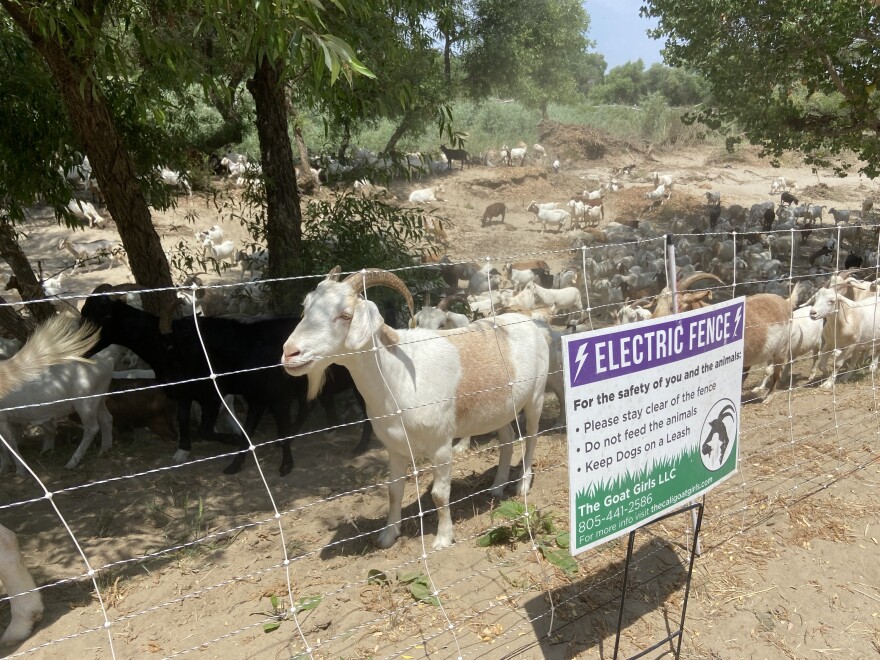
“People drive by and yell, ‘We love the goats!’ or ‘Thank you for what you're doing,' and so we’re just gonna keep going.”
Reynolds hopes San Luis Obispo County will take on similar projects in the future and expand grazing to larger areas.
As Reynolds and I stand here among the goats and sheep, it feels as if we’ve become a part of the herd. The once-hesitant goats are now relaxed, nuzzling their heads against us.
Reynolds grabs a hose and fills a tub with water; the goats eagerly gather around for a drink.
“It's hard at times because goats are a little bit difficult, but it's a pretty cool gig,” Reynolds said. “I enjoy being out here in the morning. There's birds going crazy; there's just birds singing all morning; the goats are munching away, and it’s just very harmonious to be out here with them.”
CalFire said this year’s storms left behind a lot of wildfire fuel, which means we could see more severe fires. SLO County residents can find out how to prepare for local wildfires at readyslo.org.


